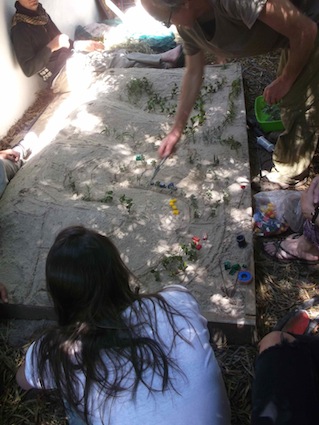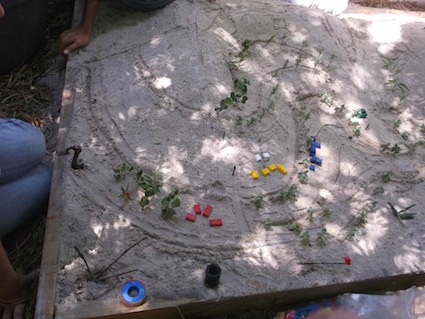Dear Reader, in this age of AI created content, please support with your goodwill someone who works harder to provide the human-made. Sign up at the top of the lefthand column or bottom of this page. You will receive my hand illustrated monthly newsletter RESTORE NATURE and access to the biodiversity garden design course as I write...and nothing else, I respect your time. I am also removing the advertizing as best I can as its become intrusive inappropriate and pays me nothing.
yeomans keyline system modeled in sand

keyline, hydrology, keyline system, yeoman’s, water conservation
Tahir Cooper explained Yeomans keyline system to us. Tahir is highly experienced in the regeneration of farms with earthworks and permaculture methods. He has helped many farmers and we were privileged to learn from him the basic principles of this form of land regeneration.
The system we learned is founded on the keyline design system of Percival Yeomans, an Australian miner, farmer and inventor. The keyline system helps with the location of dams and earthworks that manage water flow and water penetration to regenerate land, and has been adopted by farmers all over the world.

A major part of the regeneration of dry land on a permaculture farm, and in a smaller space like a garden, is to create a ‘sponge’ for absorbing water and stopping rapid runoff from the land with various kinds of earthworks such as dams, terraces, tree pans and contour swales. When walled off in some way, the water soaks into the ground instead of running over it, allowing soil life to resurge, and feeds underground water supply. Swales are trenches on contour, which spread water from the valleys where the streams or the drainage usually run, and lets it soak into the earth over a greater area.
Another major technique in Yeoman’s keyline system is ripping, a type of deep ploughing which does not turn over the earth, but opens a slit in it to let in air, and allow water to penetrate and drain in the direction you wish to direct it. Ripping can even direct water towards the ridges, by inclining the cuts in this direction, so that these normally dry areas become more fertile.
To accomplish the right type of waterflow in such a system,
accurate surveying of the contours is necessary.
This form of land management is a no-till system, the basis of permaculture. Turning the soil it is proposed, destroys its layered structure and kills organisms which are usually subterranean by exposing them to light, heat and dryness. Soil regeneration is accomplished by stopping tillage and increasing soil humidity, slowing water with earthworks, be they merely one brick high terraces around your vegetable beds, and increasing its humic content with thick mulching in the areas of intensive management where higher maintenance plants grow. A vegetable garden would usually have heavy straw mulch, and also be treated with ‘chop and drop’ mineral mining plants such as comfrey and yarrow.
Once the earthworks are done, there may be no more ploughing for several years. Tahir has seen farms treated in this way, on which dried up streams have started to flow again, due to the slowing and deep penetration of water. This is because rain in dry areas normally comes in bursts or mini floods, and if it runs off fast, takes water rapidly away from the area it is needed, as well as causing flood damage and erosion.
------
home page for more useful information on eco friendly gardening and green living
------
vegetable gardening the natural low cost way
------
------
permaculture design course in Noordhoek
Restore Nature Newsletter
I've been writing for four years now and I would love to hear from you
Please let me know if you have any questions, comments or stories to share on gardening, permaculture, regenerative agriculture, food forests, natural gardening, do nothing gardening, observations about pests and diseases, foraging, dealing with and using weeds constructively, composting and going offgrid.
SEARCH
Order the Kindle E-book for the SPECIAL PRICE of only
Prices valid till 30.09.2023
Recent Articles
-
garden for life is a blog about saving the earth one garden at a time
Apr 18, 25 01:18 PM
The garden for life blog has short articles on gardening for biodiversity with native plants and regenerating soil for climate amelioration and nutritious food -
Cape Flats Sand Fynbos, Cape Town's most endangered native vegetation!
Apr 18, 25 10:36 AM
Cape Flats Sand Fynbos, a vegetation type found in the super diverse Cape Fynbos region is threatened by Cape Town's urban development and invasive alien plants -
Geography Research Task
Jan 31, 25 11:37 PM
To whom it may concern My name is Tanyaradzwa Madziwa and I am a matric student at Springfield Convent School. As part of our geography syllabus for this
"How to start a profitable worm business on a shoestring budget
Order a printed copy from "Amazon" at the SPECIAL PRICE of only
or a digital version from the "Kindle" store at the SPECIAL PRICE of only
Prices valid till 30.09.2023







